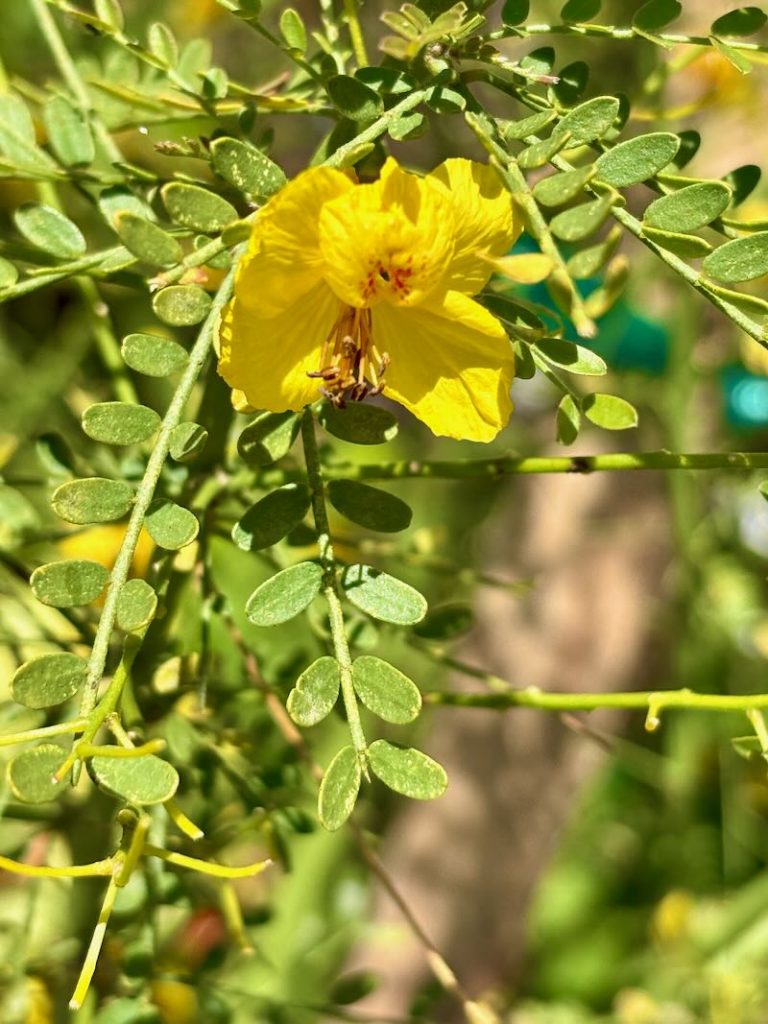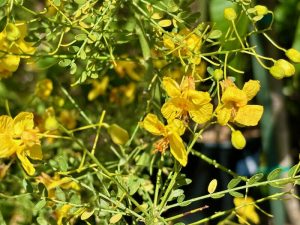Cercidium ‘Desert Museum’: A Thornless Jewel of the Desert
Cercidium ‘Desert Museum’, also known as Parkinsonia ‘Desert Museum’, is one of the most admired trees for desert and xeriscape gardens. Commonly called Desert Museum Palo Verde or Palo Verde ‘Desert Museum’, this small, fast-growing tree combines beauty, resilience, and low maintenance. Belonging to the Pea family (Fabaceae), it thrives in arid landscapes while offering a striking display of golden blooms and sculptural form.
Gardeners across the American Southwest cherish this cultivar for its thornless branches, vivid green bark, and clouds of bright yellow flowers that last for months. Unlike its thorny and sometimes messy parents, the ‘Desert Museum’ hybrid offers elegance with minimal upkeep. Its ability to flourish in poor soils, survive extreme heat, and provide filtered shade makes it a standout choice for sustainable landscapes.
The Origins of Desert Museum Palo Verde
The Desert Museum Palo Verde is a carefully bred hybrid developed at the Arizona-Sonora Desert Museum in Tucson. Horticulturist Mark Dimmitt selected it from seedlings that combined the traits of three palo verde species:
- Mexican Palo Verde (Parkinsonia aculeata)
- Blue Palo Verde (Parkinsonia florida)
- Foothill Palo Verde (Parkinsonia microphylla)
The result was a thornless tree that grows rapidly, resists pests, and blooms for exceptionally long periods. With its sterile flowers, the tree produces no seed pods, which keeps it tidy in gardens and patios.
The genus name itself has shifted over time. Earlier, palo verde trees were classified under Cercidium, and the name persists in many nursery catalogs. Today, the accepted name is Parkinsonia, but both appear in horticultural references.
Distinctive Characteristics
One of the most remarkable features of Palo Verde ‘Desert Museum’ is its smooth, green bark. Unlike many trees, its bark photosynthesizes, allowing it to continue producing energy even when the leaves drop during drought or cold. This adaptation gives it resilience in extreme climates.
The flowers, which are bright golden yellow, begin in spring and may last two months or more. Even after the initial bloom, the tree often produces additional flushes of flowers throughout summer. These blossoms attract pollinators like bees, creating a lively habitat in the garden.
The leaves are small and finely divided, giving the tree a light, airy appearance. This open canopy provides enough filtered sunlight for gardeners to grow shade-tolerant plants beneath it, including vegetables such as tomatoes, peppers, and strawberries.
Mature trees reach about 6–9 meters (20–30 feet) in both height and width. With proper care, they can grow as much as 2.5 meters (8 feet) per year during their early years. Their upright, vase-like habit makes them excellent focal points for residential gardens, parks, and streetscapes.
Growth Habit and Environmental Tolerances
Cercidium ‘Desert Museum’ is exceptionally well adapted to desert conditions. It thrives in USDA hardiness zones 8 and 9 and is especially popular in Arizona, Nevada, New Mexico, and Southern California.
Saplings can suffer damage if temperatures fall below –9 °C (15 °F), but mature trees generally withstand the occasional desert frost. The tree requires full sun for best growth, and it tolerates heat and drought once established. Unlike some species, it does not adapt well to humid coastal climates, where it may develop powdery mildew.
Because of its deep root system, the Desert Museum Palo Verde withstands wind and poor soils. It grows in sandy, rocky, or clay-based soils as long as drainage is adequate.
How to Grow Cercidium ‘Desert Museum’
Growing Palo Verde ‘Desert Museum’ is straightforward, especially for gardeners in dry climates.
Light
Plant it in a location with full sun exposure. At least six to eight hours of direct sunlight daily are essential for strong growth and heavy flowering.
Soil
The tree adapts to most well-drained soils. It grows well in sandy, gravelly, or loamy ground. Heavy clay is acceptable if drainage is good. Avoid sites where water pools after rain, as standing water can lead to root rot.
Watering
During the first one to two years, water deeply and regularly to help the tree establish strong roots. Once established, water only every two to four weeks during dry months. In winter, reduce watering significantly. Overwatering leads to weak growth and potential disease.
Fertilizing
This tree rarely needs fertilizer. In fact, excess nitrogen may reduce flowering. If growth seems stunted in poor soil, apply a balanced slow-release fertilizer once in spring. Otherwise, rainfall and natural soil nutrients are sufficient.
Pruning
Minimal pruning is needed. Shape the tree after flowering to encourage a strong structure. Remove crossing branches and thin the canopy slightly to improve air circulation. Watch for co-leader trunks and choose one dominant stem to prevent weak branch unions.
Propagation of Cercidium ‘Desert Museum’
Cercidium ‘Desert Museum’ is usually grown from cuttings or nursery propagation rather than seed. Because it is a sterile hybrid, seeds do not develop, which eliminates the mess of seed pods common to other palo verde trees. Nurseries often propagate it on its own roots, not grafted, which avoids problems with rootstock suckering.
Pests and Diseases
For the most part, the Desert Museum Palo Verde resists pests. However, two problems may arise:
- Powdery Mildew: In humid or coastal regions, white mildew may appear on leaves and branches. Treat with a fungicide if needed, but prevention is best achieved by planting in arid areas.
- Palo Verde Root Borer: This large beetle larva tunnels into roots, sometimes killing young trees. Gardeners should inspect root systems for signs of infestation and apply appropriate soil insecticides if necessary.
Otherwise, the tree is considered low-maintenance and long-lived.
Seasonal Beauty and Flowering
The flowering season of Desert Museum Palo Verde is one of its greatest assets. The main bloom occurs in spring, when the entire canopy bursts into golden blossoms. These flowers last up to two months, far longer than most ornamental trees.
After the primary bloom, sporadic flowers may continue into summer. This extended flowering makes the tree a focal point in gardens well beyond the typical spring display. Combined with the green bark and airy leaves, it provides year-round interest.
Recommended Uses in the Garden
Garden designers value this tree for its versatility. While it does not cast dense shade, it offers dappled light that works well for companion planting. Cactus gardens, native wildflower patches, and low-water vegetable beds all benefit from its filtered canopy.
Its thornless nature makes it safe near patios, walkways, and play areas. Because it produces no messy seed pods, homeowners appreciate its cleanliness compared to other palo verde species. In larger landscapes, groups of Desert Museum Palo Verde trees can create natural-looking groves with seasonal brilliance.
Why Choose Cercidium ‘Desert Museum’?
Gardeners select this cultivar for several reasons:
- It grows rapidly, reaching maturity in a few years.
- Its flowers last longer than those of its parent species.
- Thornless branches make it safe and easy to maintain.
- The tree tolerates drought and poor soils, requiring little care once established.
- It adds sculptural beauty with its vase-shaped form and vibrant bark.
For those gardening in desert regions, few trees match its combination of toughness and ornamental value.
Final Thoughts
Cercidium ‘Desert Museum,’ also known as Desert Museum Palo Verde, has become one of the signature trees of the American Southwest. With its golden flowers, thornless branches, and ability to thrive in heat and drought, it is both practical and beautiful. Gardeners who want a fast-growing tree for xeriscaping or desert landscapes will find it an outstanding choice.
Whether you call it Palo Verde ‘Desert Museum’ or Parkinsonia ‘Desert Museum,’ this tree offers the best of desert gardening: low water use, striking beauty, and resilience. Plant it where full sun and well-drained soil meet, and enjoy the year-round appeal of one of the desert’s finest ornamental trees.



